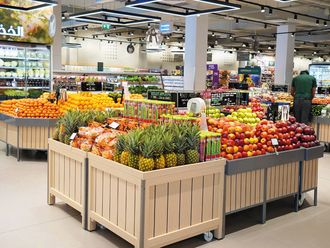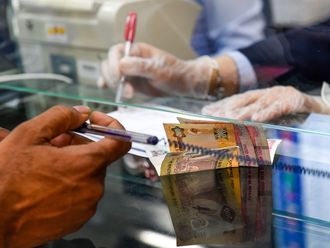
Dubai: Whether you want to invest for retirement or grow your savings, it’s best when you put money to work in markets and set it and forget it. But successful short-term or long-term investing isn’t as simple as just throwing money at the stock market.
Invesco, a US-based investment manager with operations in Dubai, UAE, published its asset allocation outlook for the second quarter of 2021, highlighting its optimal asset allocation for the next 12 months, the brokerage’s global market strategy office revealed in its latest report.
The investment experts at Invesco anticipate that 2021 will see a move towards global economic normality, with strong economic and profit growth throughout the year.
Vaccine rollout boosts economic prospects
“Given the apparent success of vaccine rollouts in the developed world, we believe the global economy will show solid growth in 2021, partly as a function of a rebound from deep recession, partly due to a gradual release of pent-up demand and also due to economic fiscal support, especially in the US,” said Paul Jackson, Global Head of Asset Allocation Research at Invesco.
“At the same time, we expect major central banks to continue providing generous support.”
When it comes to one’s investment portfolio, the strategists favour cyclical assets, with indicators signaling that the global economic cycle is heading in the right direction, and that market sentiment has improved markedly since a year ago.
But first, let’s understand what it means by cyclical stocks and how it differs from defensive stocks.
What are cyclical assets and how to choose between them and defensive stocks?
Depending on one’s financial goals, stocks have to be cherry picked. As there are two types of stocks namely cyclical and defensive, one has to choose stocks according to one’s need.
Cyclical stocks are those that give high returns but are associated with high risk as well as defensive stocks give stable returns irrespective of the market condition.
Cyclical stocks represent companies that make or sell discretionary items and services that are in demand when the economy is doing well. They include restaurants, hotel chains, airlines, furniture, high-end clothing retailers, and automobile manufacturers.
Cyclical stocks don’t perform well when the market is down. If safety is your priority, choose defensive stocks. If high returns are your priority and you can afford to take risk as well, go for cyclical stocks.
To offset your risk, you should have both cyclical and defensive stocks in your portfolio. This will put you in a win-win situation. You can get high returns from cyclical stocks when the economy is doing well and you can get stable returns from defensive stocks when the economy is witnessing a downtrend.
Some potential market pressures seen
However, the analysts also cite five factors that could potentially put pressure on cyclical assets:
1. The risk that the pandemic doesn’t go away and global economic disruption continues
2. Collateral damage, particularly amid scaled-back government support to businesses and households, which could dampen the global economic recovery
3. An increase in inflation, causing central banks to tighten their monetary policy, which could bring the risk of market dislocations
4. A potential change in correlation regimes, especially between equities and bonds, and,
5. The fact that markets have already priced in a lot of recovery, and has no further room to rise
“Each of these could lead us to adjust our preferences, usually in a more defensive direction,” noted Jackson.
“We think the most likely problem is that markets have priced in a lot of recovery,” Jackson further added. “If we are to remain positive about cyclical assets, we need to become even more aggressive in our assumptions about growth and valuation multiples.”
Best returns seen in real-estate, commodities, high-yield bonds
Over the next 12 months, Invesco sees best returns on equities, real estate, commodities and high-yield bonds. However, they are most optimistic on real estate as they believe that elevated REIT yields will mitigate against the upward pressure from bond yields.
“While real estate may suffer a loss of demand for office and retail space as a result of COVID-19, we find the yields to be attractive, with a lot of bad news apparently already priced in and expect growth to resume as economies recover,” the analysts noted.
Bond yield is the return an investor realises on a bond. The current yield is a function of the bond's price and its coupon or interest payment, which will be more accurate than the coupon yield if the price of the bond is different than its face value.
What about gold, agricultural commodities?
Although commodities gains are supported by this, experts at Invesco now consider some commodities – particularly energy and industrial metals – to be expensive and believe that gold will struggle in an environment of rising yields and a strengthening US dollar.
Agricultural commodities are the only commodities group the analysts currently consider cheap.
“Despite low returns, cash remains their defensive asset of choice on account of its stability and low correlation to other assets,” the Invesco strategists added.
“Their best-in-class assets, based on 12-month projected returns, are UK equities, emerging market real estate, US high-yield bonds and US Dollar cash. Regionally, we favour Europe and the emerging markets as regions that they believe have most to gain during an expansionary phase of the global economy.”
What rising bond yields mean for markets
Yields on US bonds recently surged to their highest level in more than a year from record lows hit in 2020, as US central bank commits to hold rates near zero for years to encourage investors to bet economic growth and inflation will heat up.
Why are yields rising? In recent months, breakthroughs in developing COVID-19 vaccines and fiscal stimulus have raised expectations the economy will bounce back. Improving risk appetite has encouraged investors to buy riskier assets such as stocks rather than bonds. Expectations of inflation have also jumped, driving bond prices lower and yields higher.
Investors generally believe yields will climb more in 2021, though some think the top economy – the US – could move to cap a rise in yields that it views as extreme enough to threaten the economic recovery.
“Critically, the experts do not expect the rise in bond yields to undermine equity markets as they expect a continuation of the positive correlation between equity prices and bond yields witnessed since the turn of the century,” the analysts added. “Similarly, they remain optimistic about the outlook for real estate, where yields remain generous compared to other assets.”








